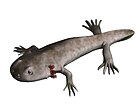Parotosuchus
| Parotosuchus Temporal range: Early Triassic
| |
|---|---|

| |
| Skull impression of P. nasutus in the Museum für Naturkunde, Berlin | |
| Scientific classification | |
| Kingdom: | Animalia |
| Phylum: | Chordata |
| Class: | Amphibia |
| Order: | †Temnospondyli |
| Suborder: | †Stereospondyli |
| Clade: | †Capitosauria |
| Family: | †Mastodonsauridae |
| Genus: | †Parotosuchus Otschev and Shishkin, 1968 |
| Species | |
| |
| Synonyms | |
| |
Parotosuchus is an extinct genus of capitosaurian temnospondyl amphibians within the family Mastodonsauridae. Fossils are known from the Early Triassic of Europe, Africa, Australia, and Antarctica. It was about 2 metres (6.6 ft) long and likely lived in aquatic environments such as lakes and rivers. Parotosuchus was covered in a scaly skin, unlike the smooth skin of modern-day amphibians, and probably moved with an eel-like motion in the water.[2]


Parotosuchus was originally named Parotosaurus. However, the name Parotosaurus was preoccupied by a genus of skinks,[3] and in 1968 the name Parotosuchus was proposed as a replacement.[4] The name Archotosaurus was also proposed as a replacement name in 1976,[5] although the author who proposed this was unaware that Parotosuchus was already in use. Because the name Parotosuchus was erected earlier than Archotosaurus, it has priority.[6]
References[]
- ^ Mikhail A. Shishkin; and Tomasz Sulej (2009). "The Early Triassic temnospondyls of the Czatkowice 1 tetrapod assemblage" (PDF). Paleontologica Polonica. 65: 31–77.CS1 maint: uses authors parameter (link)
- ^ Yahoo News: Antarctic fossil prompts rethink about amphibian history
- ^ Linkem, C.W.; Diesmos, A.C.; Brown, R.M. (2010). "A new species of scincid lizard (genus Sphenomorphus) from Palawan Island, Philippines" (PDF). Herpetologica. 66 (1): 67–79. doi:10.1655/08-074.1. S2CID 17889198. Archived from the original (PDF) on 2014-01-15.
- ^ Kalandadze, N.N.; Ochev, V.G.; Tatarinov, L.P.; Chudinov, P.K.; Shishkin, M.A. (1968). "Catalogue of Permian and Triassic tetrapods of the U.S.S.R.". Upper Paleozoic and Mesozoic Amphibians and Reptiles of the U.S.S.R. Moscow: Nauka. pp. 72–79.
- ^ Patton, R.L. (1976). "A replacement name for Parotosuchus Jaekel (Amphibia: Labyrinthodontia)" (PDF). Palaeontology. 19 (2): 415–416.[permanent dead link]
- ^ Damiani, R. J. (2002). "Parotosuchus (Amphibia, Temnospondyli) from the Cynognathus Assemblage Zone (Early Triassic) of South Africa: Cranial morphology and relationships". Alcheringa: An Australasian Journal of Palaeontology. 25 (4): 351–379. doi:10.1080/03115510108619226. S2CID 128483774.
Further reading[]
- Parotosuchus (Temnospondyli: Mastodonsauridae) from the Triassic of Antarctica. Christian A. Sidor, J. Sebastien Steyer and Ross Damiani, Journal of Vertebrate Paleontology, 2007, 27(1):232–235
- Prehistoric amphibians of Australia
- Triassic temnospondyls of Africa
- Extinct animals of Antarctica
- Triassic temnospondyls of Antarctica
- Triassic temnospondyls of Australia
- Triassic temnospondyls of Europe
- Early Triassic amphibians of Africa
- Fossil taxa described in 1968
- Prehistoric amphibian genera














